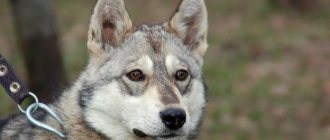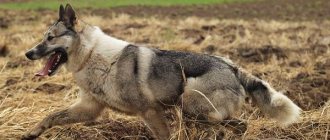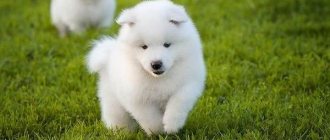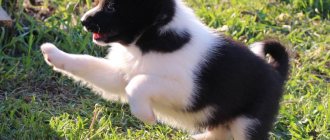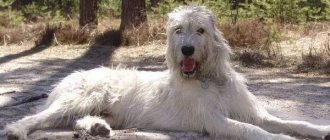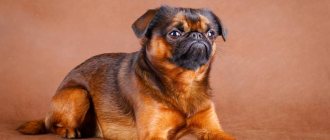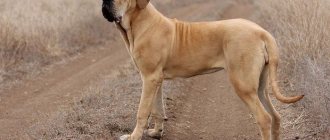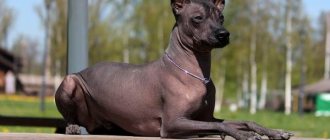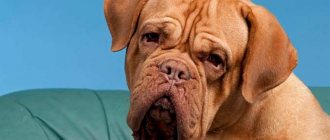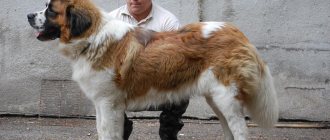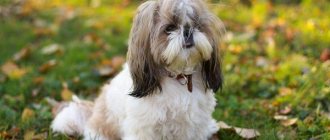Description of the West Siberian Laika breed
Popularity 16th among 263 dog breeds
Lifespan:
10-12 years
Breed group:
Hunting
Height:
males: 55-62 cm, females: 51-58 cm
Country of origin:
USSR
Average price:
10-15 thousand rubles
Weight:
16-22 kg
Latest articles Cat health
Rabies vaccination for cats: choice of vaccine, necessity, schedule 01/22/2022 4 0 0
Selection and adaptation
TOP 20 best cat breeds for families with children 01/22/2022 25 0 0
Key facts
The West Siberian Laika is dependent on human attention, so it does not feel well alone. However, on walks she is very independent. This dog needs constant supervision, otherwise it may, in pursuit of a passing car or something else, run far enough away from you and get lost.
The description of the West Siberian Laika says that they live quite peacefully with other pets, but this kindness does not affect street animals. All stray cats, pigeons or strange dogs will certainly be barked at and driven off the road.
The West Siberian Laika is by no means a gambling dog. Unlike her relatives in the section, her hunting nature does not prevent her from being more calm and balanced, and the characteristics of the West Siberian Laika breed are replete with positive reviews.
A dog left alone for the whole day in a closed apartment will inevitably begin to destroy it, and given its size and sharp mind, this process will not take it much time. If you disappear all day at work, be prepared for at least gutted pillows and overturned flower pots waiting for you at home.
Although the husky can be quite aggressive towards other animals, this does not apply to humans, so it will not make a security guard or night watchman. She will always be glad to have any guests and will always let them into the house.
Dogs of this breed are used in any type of hunting from catching birds to large animals like wild boar or bear, not to mention fur-bearing animals or other small game.
The lifespan of the West Siberian Laika directly depends on the conditions of its keeping. If its working qualities are not realized, the dog may die early.
History of the origin of the West Siberian Laika
West Siberian Laikas are descended from aboriginal hunting dogs that have lived in Siberia beyond the Ural Mountains since ancient times. Until the 20th century, many huskies of mixed breeds lived in the taiga, but from village to village they all had their own special features. Local hunters used them during their forays for game.
Of course, there could be no talk of dividing breeds then, because dogs crossed absolutely freely, and people selected the most “successful” puppies. Only by 1939 did specialists become seriously concerned about sterilization and targeted breed restriction: their attention was primarily attracted to Mansi and Khanty dogs. They performed better than other breeds during the hunt. In the same year, a meeting of Soviet dog handlers established five breed types. Among them were likes.
They took control of the breeding of huskies only in the 40s of the same century - the reason for this was the necessity declared by the state. With the outbreak of the war, the country needed money, the source of which could be meat and furs. Hunters from Siberia, along with their four-legged helpers, set out to extract these resources. The then famous kennel “Krasnaya Zvezda” took up the task of popularizing the breed, but most of the dogs at that time came from kennels in the Perm and Novosibirsk regions.
Laikas were classified only in 1947 on the initiative of E.I. Shereshevsky. Then the Khanty and Mansi dogs were combined into one West Siberian breed. Although this proposal was not accepted immediately, after 5 years the hunting breeds were replenished with three new ones, among which was the West Siberian. By the years 60-70 it was already quite popular in the USSR, and after another 10 years it was recognized by the FCI. Since then, West Siberian Laikas have been allowed to participate in international exhibitions.
Appearance of the West Siberian Laika
General impression
The breed's physique is somewhat dry, but overall quite strong. The Laika is incredibly fast and resilient when it comes to chasing prey. Males are noticeably larger than girls.
The animal's body must comply with strict proportions. For example, his body length is slightly greater than his height. In proportion it looks like this: 106/100 for males and 107/100 for females. Also, in males, the withers are 1-2 cm higher than the sacrum. In bitches this discrepancy is mostly absent or very insignificant. The front legs also pay a lot of attention, because their length should always be 50% of the animal’s height. All these nuances are noticeable in clear photos of the West Siberian Laika.
And although the Laika has been considered a factory breed for almost a century, cynologists still distinguish two types in it - Khanty and Mansi. Khanty pets are stockier, their heads are wider and resemble a triangle. Mansi dogs are usually smaller in height, and the coat is not as voluminous as that of their brothers. They also have a narrow skull and round, expressive eyes.
Head
The head of the West Siberian Laika is elongated and triangular. The skull is narrow, which is much more pronounced in females than in males. The forehead is flat. There is no special relief, the brow ridges do not stand out, the stop is smoothed. The muzzle is equal in length to the skull.
The nose is black. However, if the dog has white fur, lighter shades of gray or brown are acceptable. The eyes are oval in shape, with dark brown irises. The eyeballs are set deeper than those of other types of huskies. The ears are triangular in shape and erect.
Neck
The neck is dry, elongated, with well-developed muscles.
Torso
The husky's withers are quite prominent, which contrasts with the straight, wide back, which ends in a wide croup. The animal's chest is deep and wide. The stomach is taut. The tail is tucked up and forms a “steering wheel”, thrown to one side. When relaxed, the tail hangs down to the hocks.
Forelegs
The front legs are straight and set quite wide, which allows the dog to always maintain a stable position. The shoulder blades are laid back and long. The elbows are pressed to the body, the joints look back.
Hind limbs
The hind legs are muscular, with strong, massive thighs and vertical metatarsals. The paws are oval, but noticeably smaller than the front ones. The fingers are collected, but the middle one is slightly longer than the others.
Movement
Moves easily, does not stomp or waddle. If necessary, it goes into a gallop with lightning speed.
Wool
The coat of the West Siberian Laika is hard; the massive undercoat gives it volume. The hair on the shoulders is especially thick, which is why the dog’s neck appears to be wearing a collar. The hair on the paws is noticeably shorter than on the body. Small tufts also grow between the toes, which protect the paw from damage.
Color
There are several color options for the West Siberian Laika, approved by the standard:
- ginger;
- white;
- piebald;
- grey;
- red-brown.
Other colors are considered defective.
Size
The size of the West Siberian Laika is quite large. The average height of the West Siberian Laika in males is 58-62 cm with a weight of 19-22 kg; for females these parameters look like this: 51-58 cm at the withers and 16-19 kg. At the same time, the weight of West Siberian huskies is strictly controlled; volumes are allowed only due to their fluffy fur.
Varieties of color
The following colors are allowed by the standard:
- zonal gray;
- zone-red;
- grey;
- ginger;
- fawn and reddish-brown of all shades;
- pure white or two-color (piebald), that is, white with spots of any color listed above and similar to the main color.
Character of the West Siberian Laika
Laikas are incredibly active creatures, so you should think twice before inviting this creature into your home. Do you have enough patience and energy to maintain such a pet? If not, then you risk turning your and her existence into a constant struggle for territory and interests.
Don’t forget that huskies have their name for a reason. They really enjoy barking. They perceive this not as a means to attract your attention, but as a full-fledged communication. Therefore, as soon as the animal crosses the threshold of your home, your home will be filled with ringing barks for the next few years.
Laikas are excellent hunters and athletes due to their innate qualities, in particular, activity, playfulness and curiosity. But they cannot always be good pets; the nature of the West Siberian husky does not suggest this. So, if you are not interested in seasonal hunting, getting such a dog is pointless. You should not deprive your dog of his only favorite activity.
This dog has a simple attitude towards people. Any two-legged animal is either a friend or an excellent reason to make friends. Of course, you can always train the animal to drive strangers away from home, but by nature, huskies are extremely friendly. If she guards the owner’s property too vehemently, this indicates her unstable psyche, which is unacceptable for hunting dogs.
West Siberian huskies are creatures with a highly developed pack instinct. They will never compete with a weaker individual. Thanks to this, they are considered good nannies. They treat children with kindness and some patronage. It’s pointless for the breed to argue with the owner, because it’s much more interesting and fun to work in a team than to download your license and find out who’s boss in the pack.
The hunting instinct of these dogs is incredibly developed, which makes itself felt not only in the wild. Laika will never tolerate an animal in her company that she is not personally acquainted with. Any violator will be barked immediately. Therefore, keeping two West Siberian males in one house is a dubious pleasure. Dogs will spend the rest of their lives trying to figure out which of them is more important in the house.
Education and training
The first thing the owner must understand is that the husky is not a circus poodle; it will not perform acrobatic tricks. In addition, this breed is stubborn and self-willed, plus it quickly loses interest in activities.
You can start raising and training the West Siberian Laika as early as 3 months. Standard methods work great, but you should make sure that the baby does not get overtired and introduce new exercises, diluting them with games. It is advisable to go to group classes with your baby. There, the puppy’s pack instincts will kick in, and learning will go much faster. You can train a dog to hunt only after it has completed the OKD course.
Prohibitory commands require special attention. The breed is characterized by excessive independence, which must be clearly monitored and corrected by the owner. Big trouble awaits you if the dog for some reason does not respond to the prohibition command. With incredible ease and grace, a dog can escape, carried away by the hunt for a street cat.
It is also impossible to force a dog to follow a line. Wearing slippers and drinking tea at 5 o'clock will never be likeable. She is a hunter, not an intellectual, and she will master etiquette exactly as much as is necessary for a comfortable life in a human home.
In terms of hunting, the husky is a generalist. It is used to catch any game: from a simple hare to a large wild boar or even a bear. These dogs' sense of smell is incredibly well developed. In addition, the status of the best hunters helps to maintain viscosity (search for a scent and the ability to pursue a target for a long time) and a ringing bark. West Siberian dogs can find an animal by following an old trail, which is not possible for all representatives of the section.
If your goal is to raise a funny puppy into a real hunter, and not just a dog with a diploma, visit training grounds less often and spend more time in nature, where the dog can try his hand at catching a real animal. No matter how smart the husky is, it makes no sense to make it a universal hunter. She will not bring you a squirrel today, a fox tomorrow, and a boar the day after tomorrow. Of course, there are exceptions, but this only confirms the rule that only a select few have such a gift.
The extent to which the West Siberian Laika's hunting instincts are developed depends only on how often it is in the wild. If you are in the forest only once or twice during the entire season, do not expect the dog to demonstrate the outstanding abilities of a natural hunter.
For a dog, going hunting is not a holiday or a vacation, but a natural need. Laika should feel as confident in the wild as she does in her own home. It is better not to delay training your puppy.
At the age of six months, the puppy can already be taken with you on outings, teaching him to walk nearby and remember new smells. By 10 months, you can accustom the puppy to prey. This will be much easier if you already have a hunting dog in the house, because the baby has someone to learn from. If by the age of 2 you have not taught your husky to hunt, further training will be pointless.
Looking for a West Siberian Laika? Find your pet from 1 offer As a gift
Application
The standard description of the breed characterizes REL exclusively as a hunting dog for wide use. Dogs calmly and purposefully chase prey for a long time, regardless of weather conditions. A developed reaction helps huskies coordinate movements alone and as part of a pack. Dogs hunt down prey using barking and cunning.
REL aggression is shown only towards the object of hunting and never towards people.
However, dogs are wary of strangers, which makes the Russian-European, East Siberian and West Siberian Laika excellent guards. When in danger, dogs raise their voices, but do not openly attack. If desired, increased anger and wariness can be developed in an animal, but only through the authority of the owner, and not through physical punishment. By accepting the training well, REL is able to learn how to apprehend offenders.
Health and diseases of the West Siberian Laika
Possible diseases
The health of the West Siberian Laika can be considered truly standard. For centuries, the Siberian climate polished and brought it to an ideal state. Dogs that could not withstand severe frosts and snow storms did not survive. As a result, huskies developed a strong immunity to viral diseases, and along with them almost all genetic ones disappeared.
However, at present, the main defect of the breed remains physical inactivity, which entails many problems: from joint diseases to obesity.
You also need to be careful when hunting with a dog. It is not uncommon for an animal to injure itself while chasing prey - and such injuries can lead to serious complications.
It is imperative to vaccinate your husky against rabies. In nature, a dog can be bitten by a tick, snake or some wild animal. In addition, give your dog anthelmintic medications more often, because he can easily pick up worms from caught game.
Reproductive health
The West Siberian Laika's estrus begins at 13-14 months of life. If this happened earlier, there is a reason to consult a doctor, because it may be bleeding.
Beginning dog breeders often wonder how to determine when a dog is in heat? The fact is that during the period of estrus, the dog’s production of the hormone estrogen increases, which indicates the bitch’s readiness for procreation.
During the first week, the dog will begin to bleed and swell the vulva. Sometimes they end after 7-14 days, but this can be deceptive and does not mean at all that the estrus period is over.
The week after the discharge stops is the peak point when the risk of pregnancy is highest. If you are not sure that you can protect your dog from annoying suitors on the street, it is better not to take him for a walk during these 7 days. In addition, male dogs that smell the odor of heat can be extremely aggressive towards humans. This week, bleeding usually resumes, but the swelling of the vulva gradually subsides and the bleeding stops.
Mating
Female Russian-European Laikas have a six-month estrus period, which occurs at the end of winter and summer. Early mating of REL negatively affects not only the offspring, but also the health of the parents. The optimal age for the first mating is 18 months, which corresponds to 3 heats in a row. The Russian Laika is allowed to breed only after successfully passing the tests and in full compliance with the breed standard.
To choose a suitable partner, you should contact a kennel or a cynologist who provides permission for mating.
Before introducing dogs, you should find out everything about REL’s health, check documents and exclude family ties.
Mating is carried out at the dog’s home, giving the dogs time to get to know each other. There is no need to control the mating process, the couple can handle it themselves. But the owners need to be present nearby to ensure a successful outcome. To be sure, re-mating is carried out after 12-36 hours.
Features of feeding and diet
The basis of the diet of the West Siberian Laika is meat. It is not only rich in protein, but also helps restore energy spent during the hunt. Any lean meat will do - beef or lamb. Moreover, by meat we mean all sorts of sinewy trimmings, cartilage and other substandard meats that a person would not eat.
The meat should be given raw or slightly scalded with boiling water, but not boiled. Once a week, add fish to the menu, if possible cod: it should make up 25% of the entire portion.
Various cereals, low-fat fermented milk products and vegetables will not be superfluous. If necessary, add vitamins to your food, because it is quite difficult to perfectly balance a homemade diet. It is acceptable if you feed your West Siberian Laika dry and canned food, but it will cost much more, since food below the premium class will not only not satisfy the dog’s hunger, but will also cause problems with the digestive system.
Nutrition
A ready-made diet (dry food) is perfect for the West Siberian Laika. She should eat at least 800 grams of this product per day. Don't skimp on it! Buy only premium food. How to distinguish good dry food from bad? Answer: by composition. In a quality product, the main ingredient should be meat.
If your pet is fed dry food, periodically feed it with offal, fortified foods, for example, berries or vegetables, bone cartilage, fermented milk, etc. What definitely should not be included in its menu:
- Fatty foods cooked in oil.
- Pastries, cream cakes.
- Expired products.
- Fat cottage cheese.
- Stewed lamb or pork.
- Fatty fish with bones.
- Chocolate and marmalade.
Remember, your husky should eat plenty of vitamins at any time of the year, so never deprive her of the pleasure of eating a banana in winter or a fresh tomato in summer.
Care and maintenance
West Siberian huskies are almost insensitive to Russian weather conditions. They are not afraid of either severe frosts or hot summer months. The ideal place for a dog of this breed would be a spacious enclosure in the courtyard of a private house. Under no circumstances should you have such a dog in an apartment: it needs a lot of free space to live. In addition, these dogs take a long time and with difficulty to get used to the conditions of a noisy city - this is not why they ran through the Siberian taiga for centuries. Rural areas or urban outskirts are the best places to keep and care for West Siberian huskies.
There are a few things you should have before you bring a dog into your home:
- warm winter booth with soft bedding;
- two large bowls for food and water (preferably metal on a tripod so that the dog does not accidentally turn them over);
- long thick leash 2.5-3 meters;
- muzzle for walking in public places;
- toys, or rather, a lot of toys;
- a collar with a GPS tracker in case of a hunt or if your pet decides to run away from you.
Don't expect to be able to place your husky in a kennel and forget about it. Once a day you will have to change the straw or remove waste, as well as feed and water the dog. You can’t do without walks either: take the animal out to stretch its paws for 1.5-2 hours a day. The entire dog enclosure should be thoroughly cleaned once a month.
Tips for choosing a puppy
West Siberian Laika males are much more temperamental than females. They tend to run away from their owners while walking, and also to sort things out with other animals. At the same time, they look much more impressive than girls, because their breed features are clearly expressed, unlike the latter. But females are more trainable and flexible. But estrus is their only drawback, which can leave you without hunting for several weeks. So choosing the sex of a future puppy is not an easy task.
If you are buying a puppy that will be your reliable hunting partner in the future, ask about the achievements of its parents. In most cases, offspring inherit the professional qualities of their parents.
West Siberian Husky puppies should respond to you with curiosity and barking. Don't choose a baby that is too slim or overweight. The main thing is that he must be healthy in all external signs.
Find out from the breeder what litter the bitch has and how long ago the previous one was. Ideally, you should not take a puppy from the first litter, or if the dog gives birth more than once a year.
Socialization
The nature of the European husky is not suitable for keeping it in a family with small children. The dog will play with them with pleasure and show moderate affection, but will not obey them. For a northern dog, obedience is regulated only by the authority of its owner.
Socialization of REL must begin as early as possible so that the husky feels good with people and does not show nervousness and wariness.
The breed is wary of other dogs, as it acutely feels the need to defend its territory. Jealousy and the demands of a strict hierarchy make maintaining several RELs together difficult, but quite possible. The main thing is that a clearly defined leader stands out among the pack. The Russian-European husky does not get along with other animals, perceiving them exclusively as prey or a competitor.
